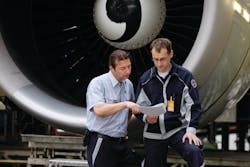How To Play By The Same Rules
Have you ever said or heard someone say
- “That’s not how we do it.”
- “Our local method works better than the job card or manufacturer’s instructions.”
- “Why do we fuel the same model in different ways for different customers?”
In ground services, where we strive for standardization and safety optimization in procedures, you would think these statements and questions wouldn’t apply. You would be wrong!
Regulatory inconsistency contributes to documentation issues and failure to follow procedures issue.
There seems to be regional and even “inspector-specific” interpretation and enforcement of regulatory requirements. For instance, regulatory oversight of technical publications in Kansas might not have the same documentation requirements as in Kentucky. Meanwhile, requirements in North Carolina may differ from North Dakota.
A panel of aviation industry and government officials, including OEMs, airlines and third-party developers, recently met to identify challenges and prioritize solutions for issues surrounding technical documentation and why it is so hard to simply “follow procedures.” (See “Procedures 101,” in the April 2012 issue of Ground Support Worldwide by Dr. Bill Johnson for more.)
After the two-day summit, the participants identified five challenges and discussed what could do done to solve them:
- FAA consistency regarding technical documentation.
- Content accuracy for users.
- Industry culture and professionalism.
- Business case for documentation improvement.
- Industry standards.
I’ll cover all of these challenges in future issues of Ground Support Worldwide, but let’s start with the first on regulatory consistency – or, rather, inconsistency.
Panel members insisted that we all need to play by the same rules. They identified two key improvements for realizing solutions:
INFORMATION QUALITY
Aircraft, engine and ground support manufacturers have studied documentation quality and tried to use industry standards to create technical instructions. But many of the engineers who write technical directions, FAA inspectors who write evaluation guidelines and FAA inspectors who evaluate documents in the field are not consistent in their practices.
Inconsistency in documentation is the result. What these groups need is a valid, reliable and straightforward way to produce and evaluate technical documentation.
There is a great deal of human factors literature available, some of it funded by the FAA, regarding the design of paper and electronic documentation. If you develop or evaluate technical documentation, check out these resources on https://hfskyway.faa.gov.
CONSISTENT STANDARDS
Inconsistent communication of expectations regarding technical information was a key contributor to regulatory oversight issues.
The participants said the solution must emerge with new regulations and guidance materials. These materials must be developed collaboratively with industry groups. Tools and training should be developed and applied in a manner that empowers both government and industry personnel to create and validate the technical instructions. Overall, there has to be more reliance on industry to assist in internal validation and acceptance of information systems.
The FAA has committed to improving relationships with stakeholders and communicating with employees exactly what is expected in their interactions with stakeholders and the public as part of the Aviation Safety (AVS) Consistency and Standardization Initiative (CSI).
As part of the initiative, stakeholders have the right to ask for review on any FAA aviation safety decision without fear of retribution. The goals of the AVS CSI are to promote early resolution of disagreements;
- promote consistency and fairness in applying FAA regulations and policies;
- encourage stakeholder feedback, including complaints;
- and enhance stakeholder satisfaction.
This is a plan for success, if we all participate.
TO DO LIST
Documentation issues and failure to follow procedures are among the most frequent error-prone hazards in the aviation system.
Unfortunately, it is an age-old problem that is ingrained in the aviation culture and will not go away on its own. Don’t expect or wait for the government to magically fix the problem.
The solutions will require significant action by all stakeholders, including manufacturers, operators, government and individual employees. What can you do?
INDUSTRIAL ACTIONS
Commit to using existing guidance material to review and revise technical documentation – especially those known to be problematic.
- Strive for standardization among all documents.
- Use voluntary reporting systems to collect documentation challenges and their root causes.
- Manufacturers should strive to validate more of their written procedures.
GOVERNMENTAL ACTIONS
- Assign responsible parties to work the issue as a collaborative process.
- Analyze the voluntary reporting data to identify common characteristics of poor documentation.
- Renew Advisory Circulars and other relevant guidance material for industry and for inspectors.
- Fund research and development to reintroduce proper documentation practices.
- Create training courses for documentation development and evaluation.
- Create special training courses for aviation safety inspectors involved in technical documentation development and oversight.
INDIVIDUAL ACTIONS
- If the documentation is unavailable or incorrect, then notify your supervisor that it isn’t possible to complete the task or complete an Aviation Safety Action Program report. Workers by regulation must follow written instructions. When individuals work without instructions, they are open to FAA disciplinary action.
- Report all suboptimal work cards or manufacturer’s instruction to your management and to FAA.
- Use the Aviation Safety Action Program (ASAP), the Aviation Safety Reporting System (ASRS), Line Operation Safety Audit (LOSA), and other voluntary reporting systems to highlight all documentation challenges.
The methodology to address the hazards associated with poor documentation and work procedures is clear. Join together and take responsibility for the problem, identify the root causes, develop viable solutions and begin them.
Dr. Katrina Avers is a Research Scientist at the Federal Aviation Administration in the Civil Aerospace Medical Institute Human Factors Research Lab. Dr. Avers takes a practical, science-based approach and has worked to develop applied solutions that can be used across the industry.
